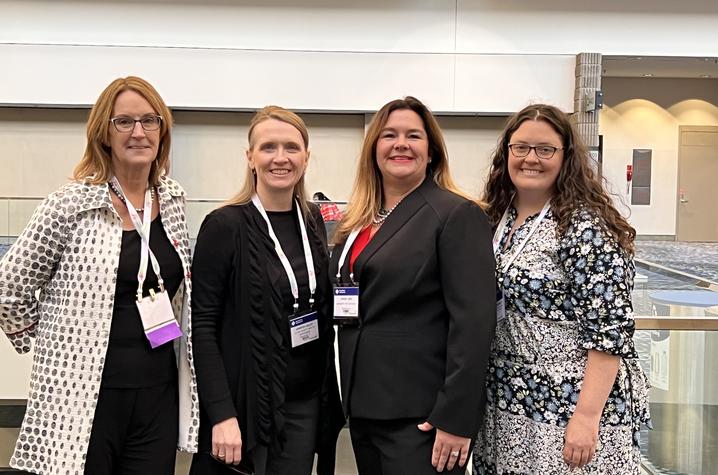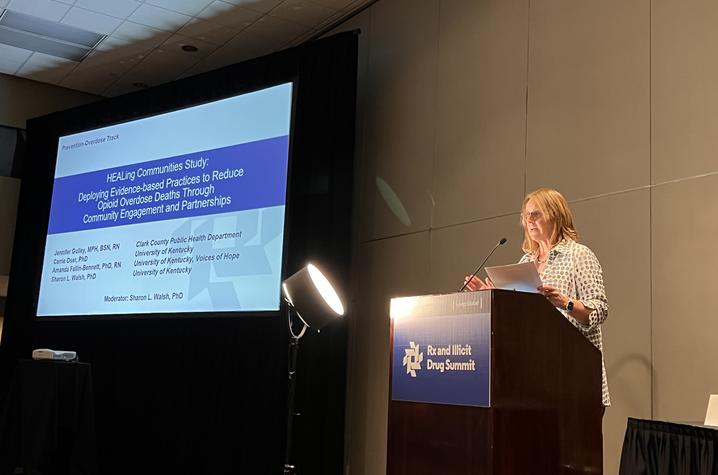HEAL Update: Study Making Impact in WAVE 1 Communities
LEXINGTON, Ky. (April 20, 2022) — More than two years into the University of Kentucky’s $87 million HEALing Communities Study (HCS) to address the opioid epidemic in Kentucky, it is possible to see the life-changing impacts it has already made in the eight counties of the study’s first wave.
Launched in 2019, the ambitious four-year study includes a multidisciplinary team of more than 25 researchers spanning seven colleges across UK, and leverages existing resources and initiatives in partnership with communities to implement various strategies to reduce opioid deaths across Kentucky.
Evidence-based practices implemented by the HCS team in partnership with behavioral/health and criminal justice agencies include effective delivery of medication for opioid use disorder (MOUD), overdose prevention education, and distribution of naloxone, a life-saving medication that reverses the effects of opioids. The team has also been working with various pharmacies and health care providers to implement safer opioid prescribing and dispensing.
The randomized study includes 16 Kentucky counties impacted by opioid abuse and is broken down into two waves of eight counties each. The first wave, collectively known as WAVE 1, includes Boyd, Boyle, Clark, Fayette, Floyd, Franklin, Kenton and Madison counties. Community coalitions in each county determined what interventions to implement based on individual community need.
With WAVE 1 nearly complete, current metrics illustrate the project’s impact so far. In partnership with 146 agencies in WAVE 1 communities, HCS has:
- dispensed 55,147 units of naloxone to 166 locations that have so far distributed 40,243 units to individuals in high-risk populations.
- assisted 38 MOUD treatment facilities with financial support for staff and transportation.
- assisted 38 agencies with implementation of peer support programs and 28 agencies with care navigation programs.
- expanded capacity for MOUD treatment, as well as linkage and retention programs in criminal justice venues including sheriff departments, pretrial services, home incarceration, drug courts, jails and probation and parole programs.
- provided 206 individuals with opioid use disorder with financial support to address barriers preventing them from getting medication treatment, including transportation, vehicle repairs, jail communication service fees and utility bills.
- provided 16 individuals with housing assistance including rent and emergency housing.
- provided transportation assistance to link and retain individuals in treatment. As of March 10, 1,531 rides to treatment programs and recovery-related appointments have been provided to 121 unique individuals for a total of 80,007 miles.
- installed medication receptacles at 35 pharmacies, with more than 1,400 lbs of medication incinerated to date.
- led educational sessions on safer opioid prescribing and dispensing for more than 150 health care professionals including dentists, primary care providers and pharmacists.
“The evidence-based practices implemented by the HEALing Communities Study team, along with state and community partners, have made an impact on thousands of lives across WAVE 1 communities. As the study continues, their work will help us better understand what’s needed in each community and where to focus and ramp up efforts to best support patients to reduce opioid overdose deaths,” said HCS principal investigator Sharon Walsh, Ph.D., a professor in UK’s College of Medicine and College of Pharmacy and director for the Center on Drug and Alcohol Research. “Our goal is that the changes implemented in these communities develop into sustainable solutions for the opioid epidemic in the Commonwealth and throughout the nation.”
The intervention also includes community engagement to assist key stakeholders in applying evidence-based practices and a communications campaign to build demand for treatment and reduce stigma toward people with opioid use disorder.
The WAVE 1 intervention ends this summer, with the sustainability phase beginning in July. This phase is intended to build capacity to help community coalitions and partner organizations sustain the evidence-based practices after the study ends. Walsh says this includes community staff and budget planning, and that HCS is also working with state partners at the Kentucky Opioid Response Effort (KORE) on sustaining naloxone distribution.
The intervention for WAVE 2 communities - Bourbon, Campbell, Carter, Greenup, Jefferson, Jessamine, Knox and Mason - begins July 1. WAVE 2 is currently in the preparation phase, which is intended to establish the infrastructure in communities to support the interventions. So far, the HCS team has had 134 meetings with 174 stakeholders and has identified 85 potential coalition members for WAVE 2.
Research reported in this publication was supported by the National Institute on Drug Abuse of the National Institutes of Health under Award Number UM1DA049406. The content is solely the responsibility of the authors and does not necessarily represent the official views of the National Institutes of Health.
As the state’s flagship, land-grant institution, the University of Kentucky exists to advance the Commonwealth. We do that by preparing the next generation of leaders — placing students at the heart of everything we do — and transforming the lives of Kentuckians through education, research and creative work, service and health care. We pride ourselves on being a catalyst for breakthroughs and a force for healing, a place where ingenuity unfolds. It's all made possible by our people — visionaries, disruptors and pioneers — who make up 200 academic programs, a $476.5 million research and development enterprise and a world-class medical center, all on one campus.






